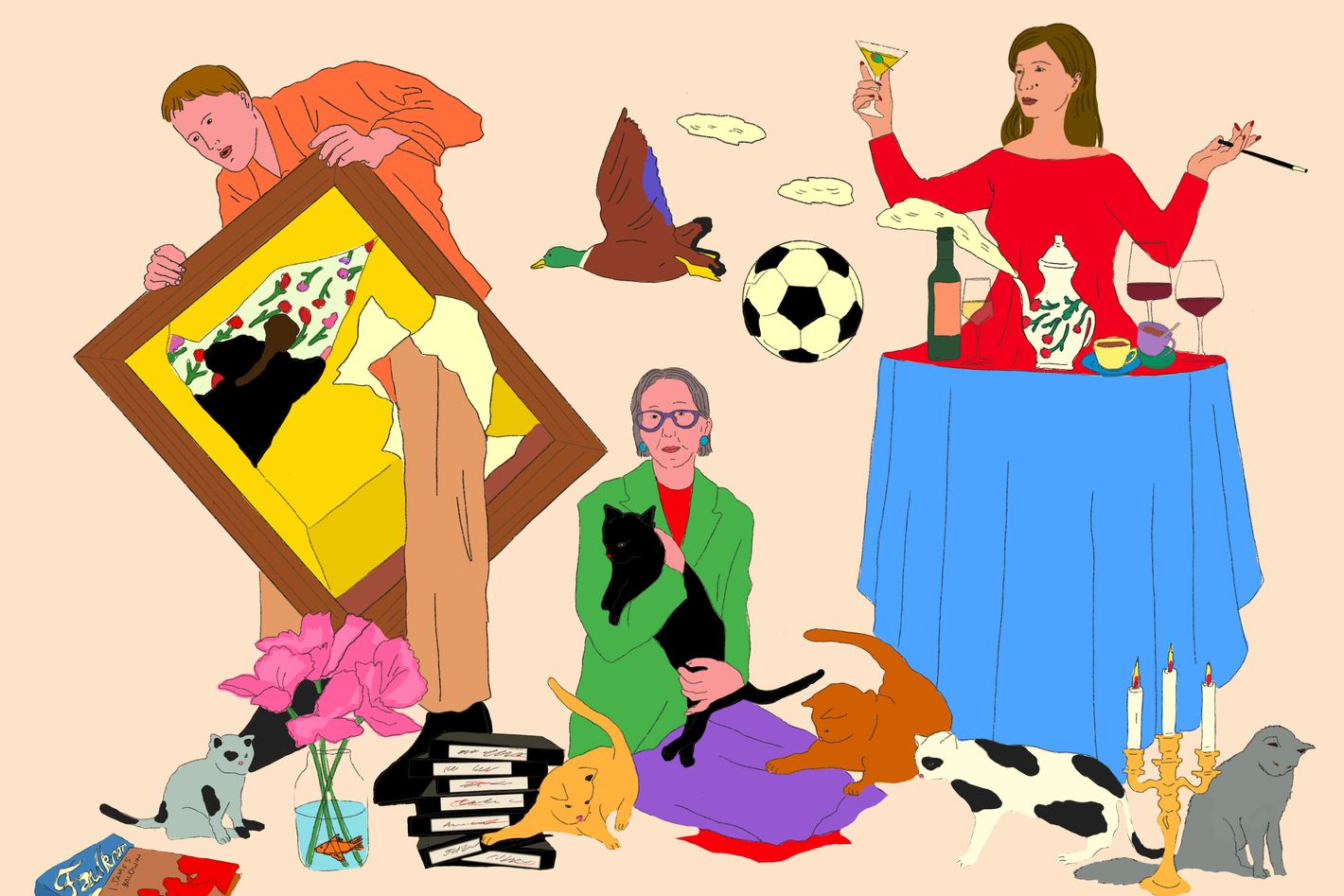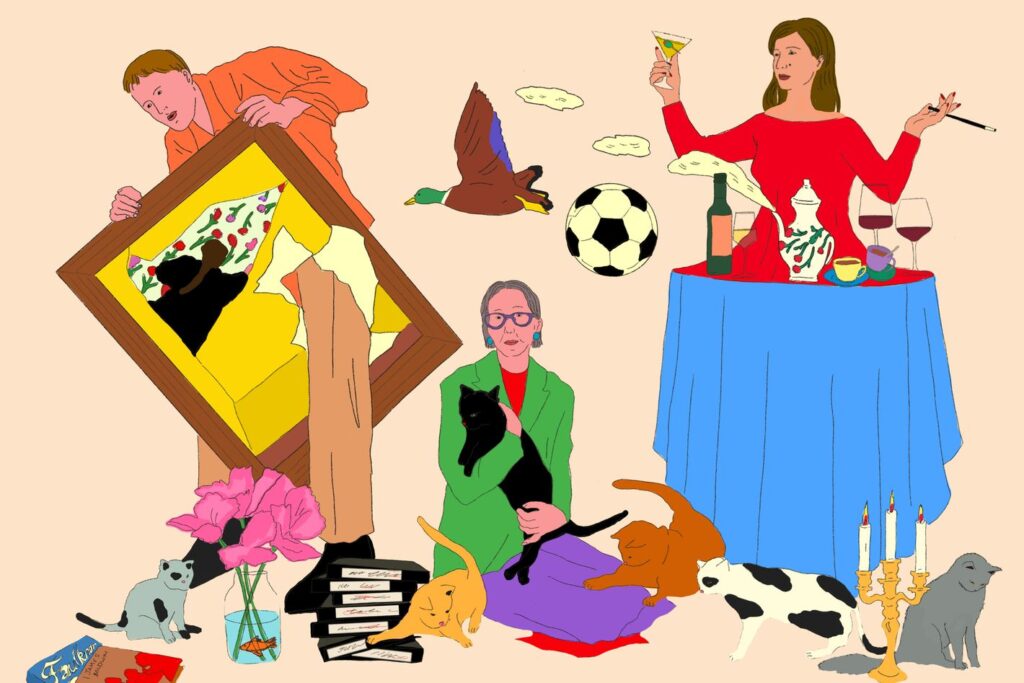
What is an author without an editor? Look to Substack for your answer. You’ll find the novelist Garth Greenwell reflecting on a single paragraph from James Baldwin’s Another Country for 3,500 words; Fuccboi author Sean Thor Conroe on “why Faulkner is goated”; a long post by Joyce Carol Oates consisting almost entirely of snapshots of her cats, Zanche and Lilith; and one by early-aughts alt-lit writer Tao Lin photographed alongside various animals including a camel, a lizard, and a dog named Binky.
Part promotional platform, part social-media site, part venue for rambling journal entries, Substack is attracting an increasing number of people who write literature for a living: George Saunders and Roxane Gay, perhaps most famously, along with authors such as Mary Gaitskill, Nana Kwame Adjei-Brenyah, and, as of this past November, Miranda July. Every month, it seems someone else has joined up, and many haven’t spent much time being publicly online before. “I don’t have any social media of any kind,” says Ottessa Moshfegh, who started her Substack, It’s Ottessa, bitch, in 2024. “I don’t know what people are doing on Instagram, but it just looks really addictive and toxic — like it was designed to hypnotize.” When she found out about Substack after a friend recommended Elif Batuman’s, its looseness reminded her of a zine: “It was very punk.”
There are serialized novels, such as Junot Díaz’s The Epic Gilgamek, a young-adult work-in-progress about a planet populated by metal robots, and The Seventh Wave, by Salman Rushdie, which wrapped up in 2022, along with several from less well known authors trying to carve out a new scene on the platform — though, like most other attempts at post-Dickens serialization, none has made much of a splash. There are intriguing upstart literary magazines, such as The Republic of Letters, which solicitsessays on a new theme each week “in a spirit of fun-loving competition.” There are diaristic pieces about writer’s block, including one from Carmen Maria Machado last year that doubles, as many do, as a sidelong apology for not posting enough. And there is lots of advice about how to publish and make money from writing. The most popular post by British novelist Emma Gannon, ranked at No. 9 in the literature category, is one from 2023 titled “How I make six figures on Substack.” It is for paid subscribers ($11 per month).
But much of what’s popping up on Substack is appealingly specific, the kind of stuff that’s unpublishable elsewhere. Spending larger chunks of time in New York after living full time in Iowa a few years ago, “I found myself boiling over with things I wanted to write about,” says Greenwell. “So I started a Substack for that, really just to have a place to put my enthusiasms.” On a trip to Washington, D.C., he saw an Édouard Vuillard painting called The Yellow Curtain at the National Gallery of Art, then spent a couple days in an NYU library reading about him, then wrote a post about that, a moving, charmingly self-indulgent close read. It didn’t feel like a waste of time to him “because it was going to be one of my two Substacks for the month.”
“There have been things that I’ve written that then an editor reached out and said, ‘Why didn’t you send that to us?’” says Brandon Taylor, author of Real Life and The Late Americans, who began posting regularly in 2021. “And I’m like, ‘Well, there’s no way you’d have wanted a 4,000-word deep dive on the similarities between the West Elm Caleb debacle and Sense and Sensibility. You would not have run that, right? And the reason that you’re reaching out is because I wrote it and people seem to have really liked it or responded to it.” (The absence of editors can have adverse effects, too, as when Saunders mistakenly reported that the short-story icon Joy Williams had died.)
Others are using it as a place to begin to write a manuscript. “I’m really exploiting it for one particular task, which is that I want to write a book about writing,” the author Lucy Sante says. “I thought, Well, Substack is a good way to force myself to do it.” She chose to limit most posts to paid subscriberssimply because doing so “makes me feel a little guilty” and thus obliges her to write. “It’s a goad, you know?” she says. “I mean, it’s not the gun at your temple, but it’s feeling your responsibility to this public you’ve assembled. And that makes it harder to slack off and decide you can’t because you’re feeling kind of blue.”
Moshfegh’s Substack follows a similar logic: It is where she can keep thinking about her next novel, which will be about a teenage boy in the ’90s, as she works on other projects. She posts interviews with former crushes, Anna Delvey, and the porn star Asa Akira about their high-school experiences; old essays and journal entries; reviews of every movie mentioned in her novel My Year of Rest and Relaxation; and joyfully petty, sometimes line-by-line responses to negative reviews, including one by New York critic Andrea Long Chu. The goal, Moshfegh tells me, is to avoid “content,”which she describes as “a paradigm, and inside of it is a need to fill blank space. It could be anything, but what I want to do is not just anything.” There is “some kind of radical weirdness there, as in anything goes in a way, but I feel like I’m building something deliberately and it’s important to me.”
People are paying for a total of 5 million subscriptions on Substack; combined, the top-ten accounts bring in more than $40 million a year. Ideally, says Sophia Efthimiatou, who runs writer relations and events at the company, about a tenth of subscribers should be paying. “If you can get it to 10 percent,” she says, “you’re golden.” Not that the platform seems to be an astonishing source of income for most authors. Some, like Taylor, haven’t even bothered to turn on the paywall. Early on, a few users, such as Gay and Daniel M. Lavery, were given sign-up bonuses to nudge them into quitting their jobs to write without an editor (though some users, it’s rumored, hire one on a freelance basis) or health insurance; that program ended in 2022, but writer recruitment still happens, albeit without the promise of an advance. Still, subscriptions are “a meaningful part of my financial picture,” as Greenwell puts it. “I make a few bucks off it,” says Sante. “It’s not like I’m going to live off it, but it’s a nice little addition to my wherewithal. It’s a kind of literary busking, and in the absence of other opportunities, it’s a good one.”
Moshfegh tells me she has about 36,000 subscribers, a “major minority” of whom pay. She didn’t want to share what she makes, but if she is hitting Efthimiatou’s standard for paid subscribers, that would mean an income of as much as $32,400 a month after Substack takes its 10 percent cut. Last year, the platform helped her hold an in-person auction with the writer and chef Eddie Huang in which paid subscribers could bid on things like a signed bottle of laxatives, a toothbrush used by Moshfegh, and a stack of VHS tapes. Four young women teamed up and won a bid for drinks with the author at the Chelsea Hotel Lobby Bar, “and it was an insane evening,” Moshfegh says. “We ended up meeting with my friend Camille, who also has a Substack, and she was like, ‘Let’s go up to my friend’s apartment’; we all went, and it was this boudoir lair. There was an immediate intimacy with these women. I felt safe with them, and they felt safe with me.”
Sante is phlegmatic when asked if Substack is doing anything strictly new. “It’s striking if you go through old magazines,” she says. “Not mainstream glossies that your grandparents got but alternative publications of various kinds. You will see things that are, for one thing, barely edited. They’re just, like, a whim the author had that day: ‘My Visit to the Zoo.’ Sometimes it’s brilliant, and sometimes it’s just crazy and pointless, and sometimes it’s drug induced.” This new platform, she thinks, at least pays a little. “If you want to go on about the subject of sneezing for 10,000 words,” she says, “nothing’s going to stop you.”
It has become the premier destination for literary types’ unpublished musings.

































































